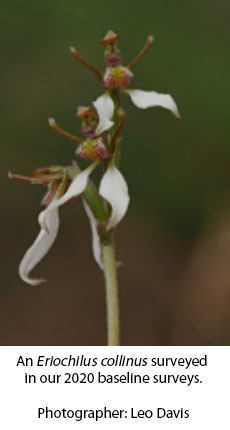<< BACK TO PROJECT LIST
Project: 332/2020
Title: Understanding the effects of season-of-burn on orchids and their mycorrhizae to inform the fire management of endangered orchids of the Mt. Lofty Ranges of South Australia
Applicant: Alexandria Thomsen
Institution: The University of New South Wales, Sydney
The Mount Lofty Ranges of South Australia is home to a high diversity of terrestrial orchid species, a disproportionate number of which are considered threatened. Although fire is a natural process in many Australian landscapes, changes are occurring to the fire regime and potentially adding to the threats faced by orchids. Orchids have a distinct phenology, where they resprout, flower and enter dormancy at particular times of the year. Historically, fires would occur during summer when orchids are dormant. However, fires can now occur throughout the year, with changes to the season of fire driven by anthropogenic climate change and managed burns in cooler months. In order to inform management of the most suitable times of the year to implement burns in order to best protect endangered orchid species, we need to understand their ecology, including how they respond to different seasonal fires.
Orchids are reliant on mycorrhizal fungi to germinate and to uptake nutrients from the soil. To gain a full understanding of the impacts of fire on orchids, it is therefore imperative to also assess the impacts of changing seasonal fires on orchid mycorrhizal fungi. We have a unique opportunity where we have collaborated with the Department of Environment and Water (DEW) to survey orchids before and after a series of prescribed burns. Funds from the Australian Orchid Foundation will be used to experimentally test how a wide range of orchid species and their associated mycorrhizae are affected by fires occurring in different seasons.

Research Outcomes:
This project revealed significant insights into the vulnerability of orchids to fire seasonality and the mechanisms driving their responses. The ex situ study showed that, contrary to the assumption that many terrestrial orchids are fire-stimulated, three out of four species displayed either reduced or unchanged abundance post-fire. The largest impacts were seen in Pterostylis curta with reduced abundance seen after autumn burns compared to control plots. Only Thelymitra rubra, a spring-flowering species, exhibited a slight increase in abundance after autumn burns. In terms of flowering, most species saw a decrease in flowering proportions, with Caladenia tentaculata showing a significant reduction. Interestingly, increased floral herbivory was observed in both burned and unburned plots, suggesting that factors other than fire may be influencing florivory rates.
The glasshouse experiment provided a greater resolution to those findings from the ex situ study, by investigating both below-ground and above-ground responses to burn season in a glasshouse study. This delivered results that not only supported the findings that autumn fires were detrimental to winter flowering Pterostylis species, but also delved into the mechanisms driving this response. This experiment was able to link the vulnerability of Pterostylis curta to autumn fires with resource allocation and timing of life cycle events. By following life cycle events such as leaf growth and timing of daughter tuber production, we found that Pterostylis curta was most vulnerable to fire events during the early stages of production of its replacement tuber (during late autumn). In fact, late autumn fire resulted in 100% tuber mortality. Another key finding is that heat alone is not the driver of tuber mortality, because soil heating was similar across all burn seasons, and plants burnt in the three other seasons were able to resprout strongly in the first growing season after fire.
This research shows that altered fire seasonality can impact orchid persistance. Currently, most recommendations for prescribed burning are to wait until late spring, when the majority of orchid species are dormant and their tubers are insulated by soil. For orchid species that are threatened or have populations that are at risk due to recent threats such as prolonged drought, our research agrees that current advice would create the lowest risk. However, our findings suggest that there is the ability to provide advice to managers that is more nuanced and species specific. For Pterostylis species and perhaps other terrestrial orchid species with a similar phenology (winter flowering) the fire exclusion window can be restricted to autumn.
Publications
Thomsen, A. M (2024) Shifting fire regime elements and their impacts on plant persistence at multiple scales. PhD Thesis (UNSW) conferred May 2024. https://doi.org/10.26190/unsworks/30077
Thomsen, A. M., Davies, R. J., & Ooi, M. K. (2024). The impacts of inter-and intra-seasonal burns on the terrestrial orchid Pterostylis curta. Plant Ecology, 1-11. https://doi.org/10.1007/s11258-024-01437-2


